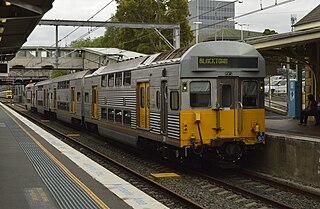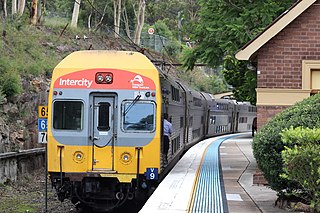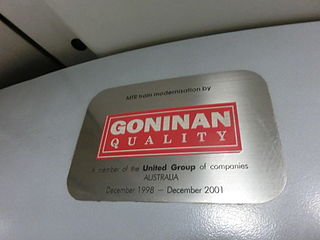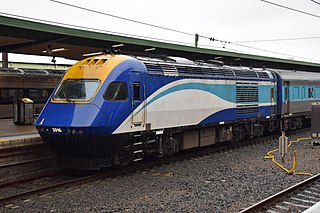
CityRail was a passenger railway brand operated by the State Rail Authority from 1989 to 2003 and by RailCorp from 2003 to 2013 with services in and around Sydney, Newcastle and Wollongong, the three largest cities in New South Wales, Australia. It was established in January 1989 and abolished in June 2013 when it was superseded by Sydney Trains and NSW TrainLink.

The T sets, also referred to as the Tangara trains, are a class of electric multiple units that currently operate on the Sydney Trains network. Built by A Goninan & Co, the sets entered service between 1988 and 1995, initially under the State Rail Authority and later on CityRail. The T sets were built as "third-generation" trains for Sydney's rail fleet, coinciding with the final withdrawals of the "Red Rattler" sets from service in the late 1980s and early 1990s. The Tangaras were initially built as two classes; the long-distance G sets and the suburban T sets, before being merged after successive refurbishments.
Kangy Angy is a semi-rural suburb of the Central Coast region of New South Wales, Australia. It is in a small valley along Ourimbah Creek and the Pacific Highway. It is part of the Central Coast Council local government area.

M1 Pacific Motorway is a 127-kilometre motorway linking Sydney to Newcastle via the Central Coast and Hunter regions of New South Wales. Formerly known but still commonly referred to by both the public and the government as the F3 Freeway, Sydney–Newcastle Freeway, and Sydney–Newcastle Expressway, it is part of the AusLink road corridor between Sydney and Brisbane.

The S sets are a class of electric multiple units (EMU) that operated on Sydney's suburban rail network from 1972 up until 2019. Originally entering service under the Public Transport Commission, the sets also operated under the State Rail Authority, CityRail and Sydney Trains. Prior to their retirement, the S sets were the last class in the Sydney Trains fleet to not be air-conditioned, earning them the nicknames "Tin cans" and "Sweat Sets". They were also nicknamed "Ridgys" because of their fluted ("ridged") stainless steel panelling; they shared this nickname with similar looking K sets and C sets. Their stainless steel appearance was also shared with the intercity V sets and U sets. All remaining sets were withdrawn from service in June 2019.

The Blue Mountains Line (BMT) is an intercity rail service serving the Blue Mountains region of New South Wales, Australia. The line travels west from Sydney to the major town of Katoomba and on to Mount Victoria, Lithgow and Bathurst. Mount Victoria is the terminus for most electric services, but some services terminate at Lithgow instead. Two express services per day in each direction, known as the Bathurst Bullet, extend to the regional city of Bathurst, which is supplemented by road coaches connecting Bathurst to Lithgow. Due to electrification limits at Lithgow, the Bathurst Bullet is run using the Endeavour railcars, which operate on diesel. The Blue Mountains Line operates over a mostly duplicated section of the Main Western line. As such, the tracks are also traversed by the Central West XPT, Outback Xplorer and Indian Pacific passenger services and by freight trains.

UGL Rail is an Australian rail company specialising in building, maintaining and refurbishing diesel locomotives, diesel and electric multiple units and freight wagons. It is a subsidiary of UGL and is based in Melbourne, with a staff of 1,200 across Australia and Asia. It operates factories in Broadmeadow (Newcastle, Spotswood and Bassendean. While it used to operate a factory in Taree, the plant was shut down and the equipment sold off.
The Sydney Trains fleet serves the metropolitan lines within Sydney, Australia. All of the rolling stock are double-deck electric multiple units and operate mainly as eight carriage sets.

The Sydney Trains H sets, also referred to as the OSCAR trains, are a class of electric multiple units (EMU) currently operated by Sydney Trains on its intercity routes and some Sydney suburban routes. Built by UGL Rail in Broadmeadow, the H sets first entered service under the CityRail brand in December 2006, with the last in December 2012. Their introduction allowed for the retirement of some second-class V set carriages. As long-distance trains, the H sets share a similar overall layout and design to the previous Tangara G sets. Currently operating as 55 four-carriage sets, the H sets now operate between Sydney, Central Coast and Newcastle and between Sydney and the South Coast.

The New South Wales XPT is a class of diesel-powered passenger trains built by Comeng and ABB. Based on the British Rail-designed High Speed Train, each XPT set comprises two XP power cars in a push-pull configuration and, between them, between four and seven passenger carriages.

The Sydney Trains A & B sets, also referred to as the Waratah trains, are classes of double-decker electric multiple units (EMU) that currently operate on the Sydney Trains network. Based on the earlier M sets, the Waratahs were manufactured by a joint consortium between CRRC and Downer Rail, with initial construction taking place overseas in Changchun before final assembly at Downer Rail's Cardiff Locomotive Workshops. The sets were named after the Waratah flower, which is the state's floral emblem.

Transport for NSW (TfNSW) is a New South Wales Government transport services and roads agency established on 1 November 2011. The agency is a different entity to the NSW Department of Transport, which is a department of the state government of New South Wales, and the ultimate parent entity of Transport for NSW.

NSW TrainLink is a train and coach operator in Australia, providing services throughout New South Wales and the Australian Capital Territory, along with limited interstate services into Victoria, Queensland and South Australia. Its primary services are spread throughout five major rail lines, operating out of Sydney's Central railway station.

Sydney Trains is the brand name and operator of suburban and intercity train services centring on Greater Sydney in New South Wales, Australia.

Sydney Metro is a fully automated rapid transit rail system in Sydney, New South Wales, Australia. It currently consists of the Metro North West & Bankstown Line, running between Tallawong and Sydenham and consisting of 21 stations on 52 km (32 mi) of twin tracks, mostly underground. The first stage of the line opened on 26 May 2019, running between Tallawong and Chatswood. This line was extended from Chatswood to Sydenham on 19 August 2024 as part of the first stage of the City & Southwest project. The second stage of the project will then further extend this line to Bankstown as part of a partial conversion of the existing Bankstown railway line with a scheduled completion in 2025.
The NSW TrainLink fleet of trains serves the areas outside Sydney, Australia, mainly interurban and interstate lines. The NSW TrainLink fleet consists of both diesel and electric traction, with the oldest of the fleet being the V sets and the youngest being the H sets.

Newcastle Transport is a public transport operator in Newcastle, New South Wales. A subsidiary of Keolis Downer, it operates bus, ferry and light rail services under contract to Transport for NSW.
The 2010s saw many developments relating to transport in the Australian city of Sydney. The decade saw a substantial investment in infrastructure, including a new airport, motorway projects, light rail lines, Australia's first metro system, the new Waratah fleet and the demise of the non-air conditioned S sets from the rail network. Planning and branding of public transport services became substantially more centralised.
The Kangy Angy Maintenance Centre is a railway depot at Kangy Angy on the Central Coast, New South Wales to maintain the NSW TrainLink D sets. The depot was officially opened on 24 February 2021.

The Sydney Metro Metropolis Stock is a class of electric multiple units that operate on the Sydney Metro network. Built by Alstom as part of their Metropolis family, the trains are the first fully automated passenger rolling stock in Australia as well as the first single-deck electric trainsets to operate in Sydney since their withdrawal from the suburban rail network in the 1990s.






















